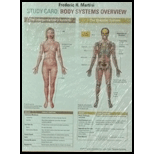
Fundamentals of Anatomy and Physiology - Study Card
1st Edition
ISBN: 9780321929303
Author: Martini
Publisher: PEARSON
expand_more
expand_more
format_list_bulleted
Question
Chapter 2, Problem 28RQ
Summary Introduction
Introduction:
Water molecules are bonded together by the hydrogen bonding in which two molecules are joined together by electrostatic attraction. In this bonding the hydrogen atom is bonded to a highly electronegative atom.
Expert Solution & Answer
Want to see the full answer?
Check out a sample textbook solution
Students have asked these similar questions
if a tomato juice has a pH of 3, how many more H+ ions are present in lemon juice with a pH of 2?
Is water polar, nonpolar, or an ion?
Why are water molecules at the surface of a drop of water closer together than those in the interior?
Chapter 2 Solutions
Fundamentals of Anatomy and Physiology - Study Card
Ch. 2 - Define atom.Ch. 2 - Atoms of the same element that have different...Ch. 2 - How is it possible for two samples of hydrogen to...Ch. 2 - Prob. 4CPCh. 2 - Prob. 5CPCh. 2 - Both oxygen and neon are gases at room temperature...Ch. 2 - Prob. 7CPCh. 2 - Prob. 8CPCh. 2 - Prob. 9CPCh. 2 - Prob. 10CP
Ch. 2 - What is an enzyme?Ch. 2 - Prob. 12CPCh. 2 - Prob. 13CPCh. 2 - Explain how the chemical properties of water make...Ch. 2 - Define pH, and explain how the pH scale relates to...Ch. 2 - What is the significance of pH in physiological...Ch. 2 - Define the following terms: acid, base, and salt.Ch. 2 - Prob. 18CPCh. 2 - Prob. 19CPCh. 2 - Describe lipids.Ch. 2 - Prob. 21CPCh. 2 - Prob. 22CPCh. 2 - Prob. 23CPCh. 2 - Describe a nucleic acid.Ch. 2 - Prob. 25CPCh. 2 - Describe ATP.Ch. 2 - What molecule is produced by the phosphorylation...Ch. 2 - 28. Identify the biochemical building blocks...Ch. 2 - 29. Define metabolic turnover.
Ch. 2 - An oxygen atom has eight protons (a) Sketch in the...Ch. 2 - What is the following type of decomposition...Ch. 2 - The subatomic particle with the least mass (a)...Ch. 2 - Isotopes of an element differ from each other in...Ch. 2 - The number and arrangement of electrons in an...Ch. 2 - All organic compounds in the human body contain...Ch. 2 - A substance containing atoms of different elements...Ch. 2 - All the chemical reactions that occur in the human...Ch. 2 - Which of the following chemical equations...Ch. 2 - Prob. 10RQCh. 2 - A pH of 7.8 in the human body typifies a condition...Ch. 2 - A(n) _____ is a solute that dissociates to release...Ch. 2 - Special catalytic molecules called _____ speed up...Ch. 2 - Which of the following is not a function of a...Ch. 2 - Complementary base pairing in DNA includes the...Ch. 2 - What are the three subatomic panicles in atoms?Ch. 2 - Prob. 17RQCh. 2 - Prob. 18RQCh. 2 - List seven major functions performed by proteins.Ch. 2 - (a) What three basic components make up a...Ch. 2 - What three components are required to create the...Ch. 2 - If a polypeptide contains 10 peptide bonds, how...Ch. 2 - Prob. 23RQCh. 2 - Prob. 24RQCh. 2 - What is a salt? How does a salt differ from an...Ch. 2 - Prob. 26RQCh. 2 - In an exergonic reaction, (a) large molecules are...Ch. 2 - Prob. 28RQCh. 2 - Prob. 29RQCh. 2 - An atom of the element calcium has 20 protons and...Ch. 2 - A certain reaction pathway consists of four steps....Ch. 2 - Prob. 32RQCh. 2 - Prob. 1CCCh. 2 - Prob. 2CC
Knowledge Booster
Learn more about
Need a deep-dive on the concept behind this application? Look no further. Learn more about this topic, biology and related others by exploring similar questions and additional content below.Similar questions
- Why does ice float in water?arrow_forwardIbuprofen, widely used as a pain reliever, has limited solubility in water, less than 1 mg>mL. Which part of the molecule’s structure (gray, white, red) contributes to its water solubility? Which part of the molecule (gray, white, red) contributes to its water insolubility?arrow_forwardDescribe the way an ionic solid dissolves in waterarrow_forward
- Excluding sodium chloride (table salt) and sucrose (table sugar), what are some examples of ionic and/covalent compounds you've encountered in everyday life?arrow_forwardDescribe the differences among acids, bases, and salts.arrow_forwarddescribe the composition and organization of water, acids, bases, salts, buffers, carbohydrates, lipids, proteins, and nucleic acids and explain the biological role of each.arrow_forward
arrow_back_ios
SEE MORE QUESTIONS
arrow_forward_ios
Recommended textbooks for you
 Human Biology (MindTap Course List)BiologyISBN:9781305112100Author:Cecie Starr, Beverly McMillanPublisher:Cengage Learning
Human Biology (MindTap Course List)BiologyISBN:9781305112100Author:Cecie Starr, Beverly McMillanPublisher:Cengage Learning Principles Of Radiographic Imaging: An Art And A ...Health & NutritionISBN:9781337711067Author:Richard R. Carlton, Arlene M. Adler, Vesna BalacPublisher:Cengage Learning
Principles Of Radiographic Imaging: An Art And A ...Health & NutritionISBN:9781337711067Author:Richard R. Carlton, Arlene M. Adler, Vesna BalacPublisher:Cengage Learning

Human Biology (MindTap Course List)
Biology
ISBN:9781305112100
Author:Cecie Starr, Beverly McMillan
Publisher:Cengage Learning

Principles Of Radiographic Imaging: An Art And A ...
Health & Nutrition
ISBN:9781337711067
Author:Richard R. Carlton, Arlene M. Adler, Vesna Balac
Publisher:Cengage Learning
GCSE Chemistry - Acids and Bases #34; Author: Cognito;https://www.youtube.com/watch?v=vt8fB3MFzLk;License: Standard youtube license